Retail Holiday Newsletter

Executive Summary
- As shoppers start to fill their carts this holiday season, early data suggests healthy sales growth.
- Despite mixed macroeconomic indicators, consumers keep spending, and Amazon anticipates double-digit global revenue growth in the fourth quarter.
- Historically, the retail juggernaut has gained share during the holidays with its battle-tested strategy. But this year, Amazon will need to contend with stronger competitors and declining consumer sentiment.
- In this issue, we explore how Amazon will push the boundaries of its winning playbook and how leading retailers can thrive alongside Amazon.
Checking on the forecast
We are now one week into the holiday season, and the latest data continues to support Bain’s projection that retail sales—defined as US in-store and nonstore (e-commerce and mail order) sales, excluding sales by auto and auto parts dealers, gas stations and restaurants—will grow 3.8% over last year. According to advance sales estimates from the US Census Bureau, in-store sales in Bain-defined retail categories grew 1.9% in September from a year earlier. Meanwhile, e-commerce sales rose 16.5%, contributing to 4.4% growth in total retail sales.
In macroeconomic news, healthy corporate profits, low unemployment and rising consumer sentiment are favorable indicators, while tariff uncertainty and mixed corporate growth projections suggest reasons for caution. Here’s what we know so far.
Shoppers have money to spend. Unemployment ticked up, albeit slightly, to 3.6% in October from a 50-year low of 3.5% in September. Disposable income continued its upward trajectory, growing 4.9% in September compared with last year.
Consumer sentiment is up. After dropping to a three-year low of 89.8 in August, the University of Michigan Index of Consumer Sentiment increased for the second month in a row, hitting 95.5 in October. While this is slightly below last year’s mark of 98.6, the upward trend is a promising signal as consumers kick off their holiday shopping.
On-again, off-again tariffs may have a negative impact on retailers and consumers. A recent Bain survey found that more than 85% of US retailers anticipate increases in their cost of goods sold this holiday season because of the trade war with China. While regulatory uncertainty continues, executives anticipate an average 4% cost increase alongside a 2% volume contraction. Of those executives who foresee higher costs, approximately two-thirds aim to pass at least some of those costs through to consumers. If tariffs are not rolled back, shoppers could absorb, on average, 23% of cost increases in the form of higher prices. Retailers that fail to take action to offset the tariff impact could face up to 400 basis points in gross margin contraction.
Some companies have lowered their revenue and profit forecasts. Apple’s stock price rose after a better-than-expected earnings report in late October. Meanwhile, Amazon made headlines when it provided lower-than-expected revenue and profit forecasts for the fourth quarter, causing its stock price to dip temporarily.
Nonetheless, Amazon’s stock price has since recovered, and the company still anticipates its global revenue to grow as much as 20% in the final quarter of the year. As retailers enter the busy shopping season, all eyes will be on Amazon’s holiday moves and whether competitors will succeed in slowing the juggernaut’s market share gains.

Will a Blizzard of Tariffs Bury Holiday Shoppers?
If the trade war continues, Bain research shows that a majority of retailers expect to raise prices.
Amazon is a holiday heavyweight
Over the past 25 years, Amazon has built a powerful system that provides a one-stop shop for customers (with a broad selection, great value, helpful product information, extensive customer reviews and a convenient experience) and all-in-one solutions for vendors (with increased scale through growing customer traffic, easy-to-use seller tools, advertising, analytics, payments and support for logistics). Its nonretail businesses, including Amazon Web Services and Amazon Advertising, account for less than 20% of the company’s forecasted revenue for 2019, but these ventures generate nearly 60% of overall profits and are rapidly growing at a 38% year-over-year clip to date.
Amazon’s core online retail business has similarly enjoyed its fair share of successes. Amazon has become the predominant starting point for e-commerce search in the US, with more users beginning their online shopping journeys on Amazon.com than on any other site, including Google. Amazon’s conversion rate—that is, the portion of its online page views that result in a sale within a given visit—was more than triple the rate of other retailers over the past year, according to Jumpshot (see Figure 1).
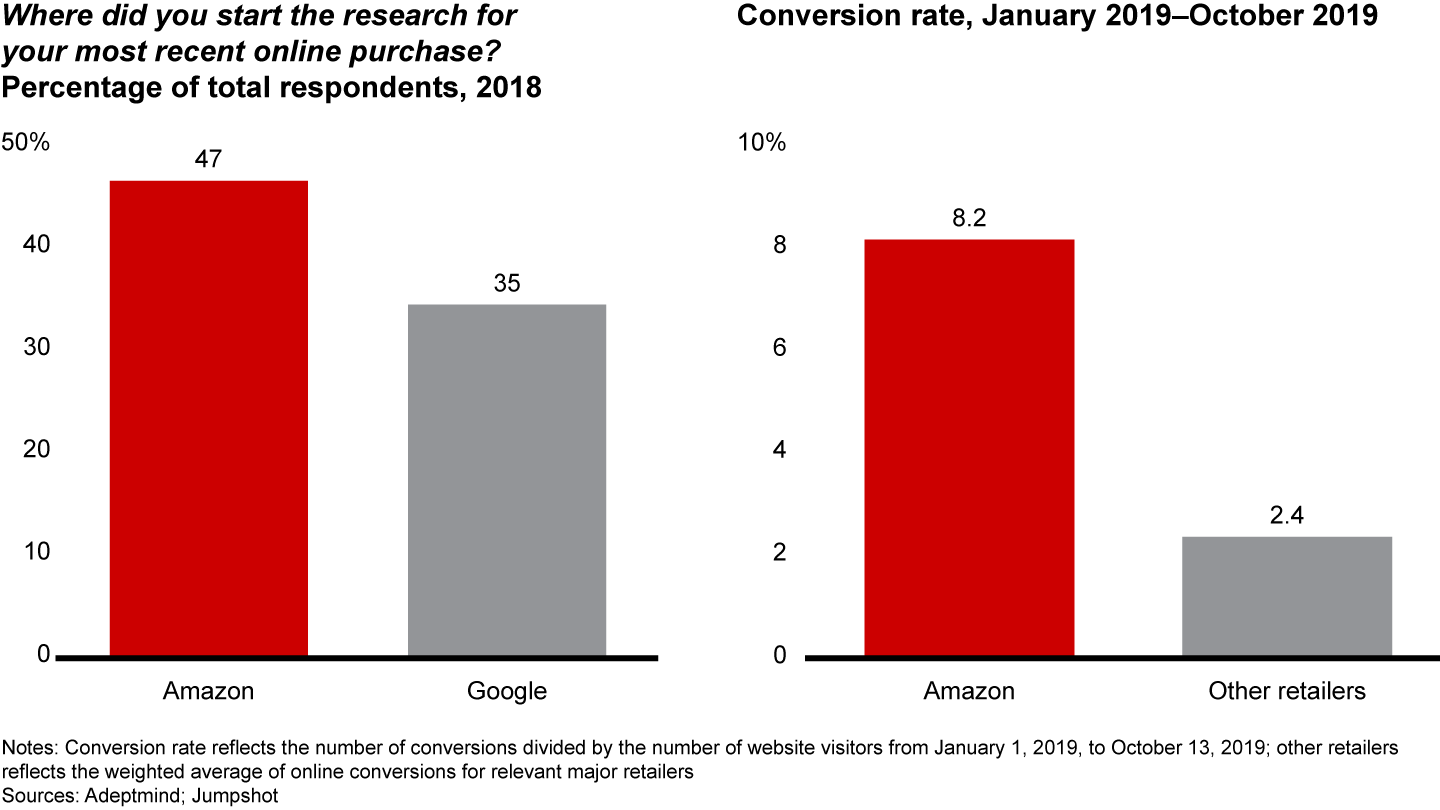

To date, e-commerce has been a winner-take-most game for general merchandise in many markets. Amazon is that winner in the US, with more than 40% of the market share. It also leads in the UK, Germany and Japan in terms of relative market share—that is, its share relative to the next largest competitor in the market. Even in other key markets where it hasn’t captured the lead, such as India, Amazon is a strong No. 2 player (see Figure 2).
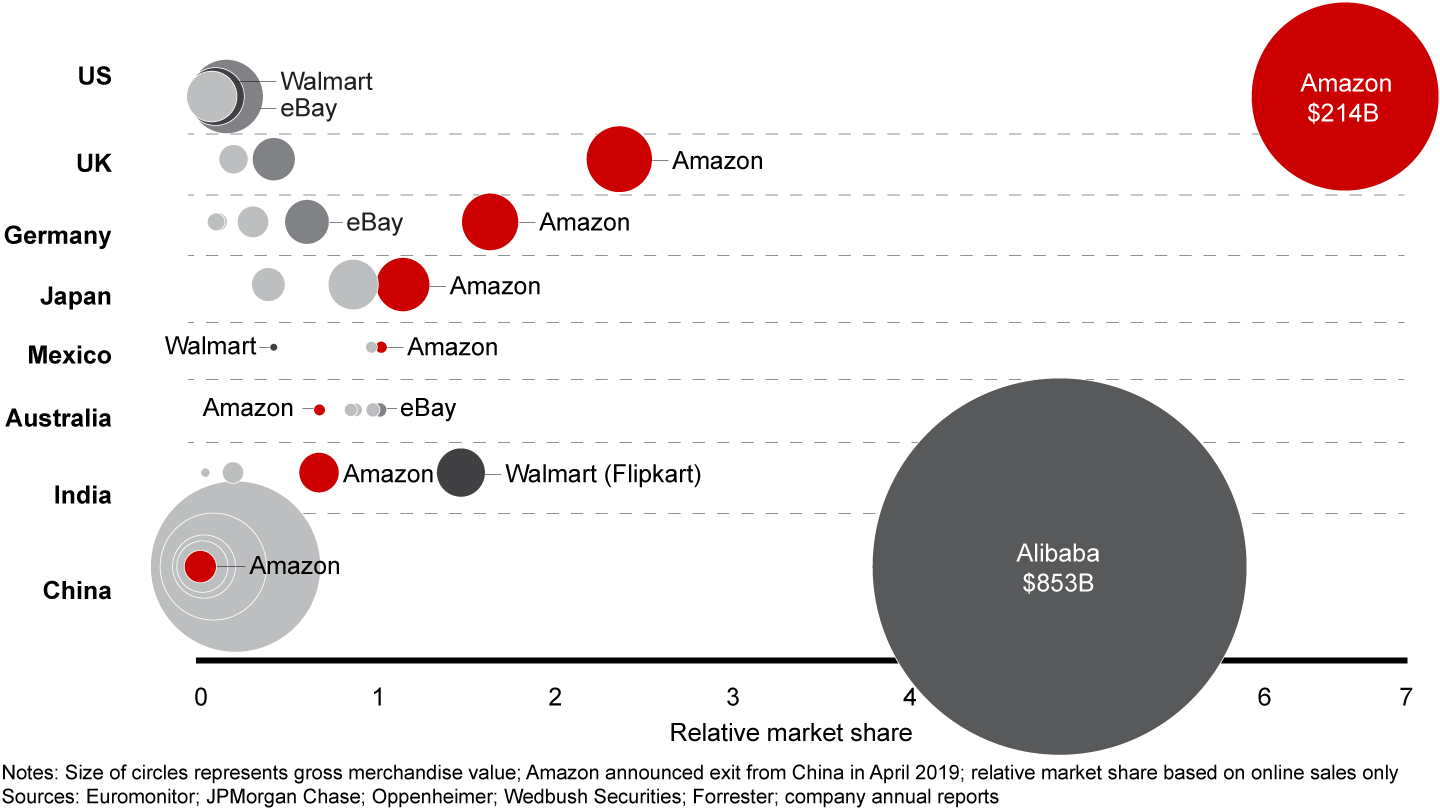

Amazon has historically won by gaining share during the holidays, with last year being no exception—the retail giant gained approximately 2 points of share in the second half of 2018 (see Figure 3). Amazon has expanded its market share by executing a battle-tested strategy of deep assortments at low prices while emphasizing aspects of the customer experience important for gifting, including recommendations, fast shipping, registry, gift receipts and easy returns. The company also has a history of making headline-grabbing announcements during the holidays that boost brand awareness via earned media. For example, Amazon struck publicity gold twice in last year’s fourth quarter—first by announcing a minimum wage increase for all employees and later by releasing the much-anticipated locations of its second headquarters. In prior years, Amazon has garnered similar attention with late-year announcements, ranging from music streaming services (Amazon Music) to smart home and auto delivery (Amazon Key) to an ambitious drone delivery program.
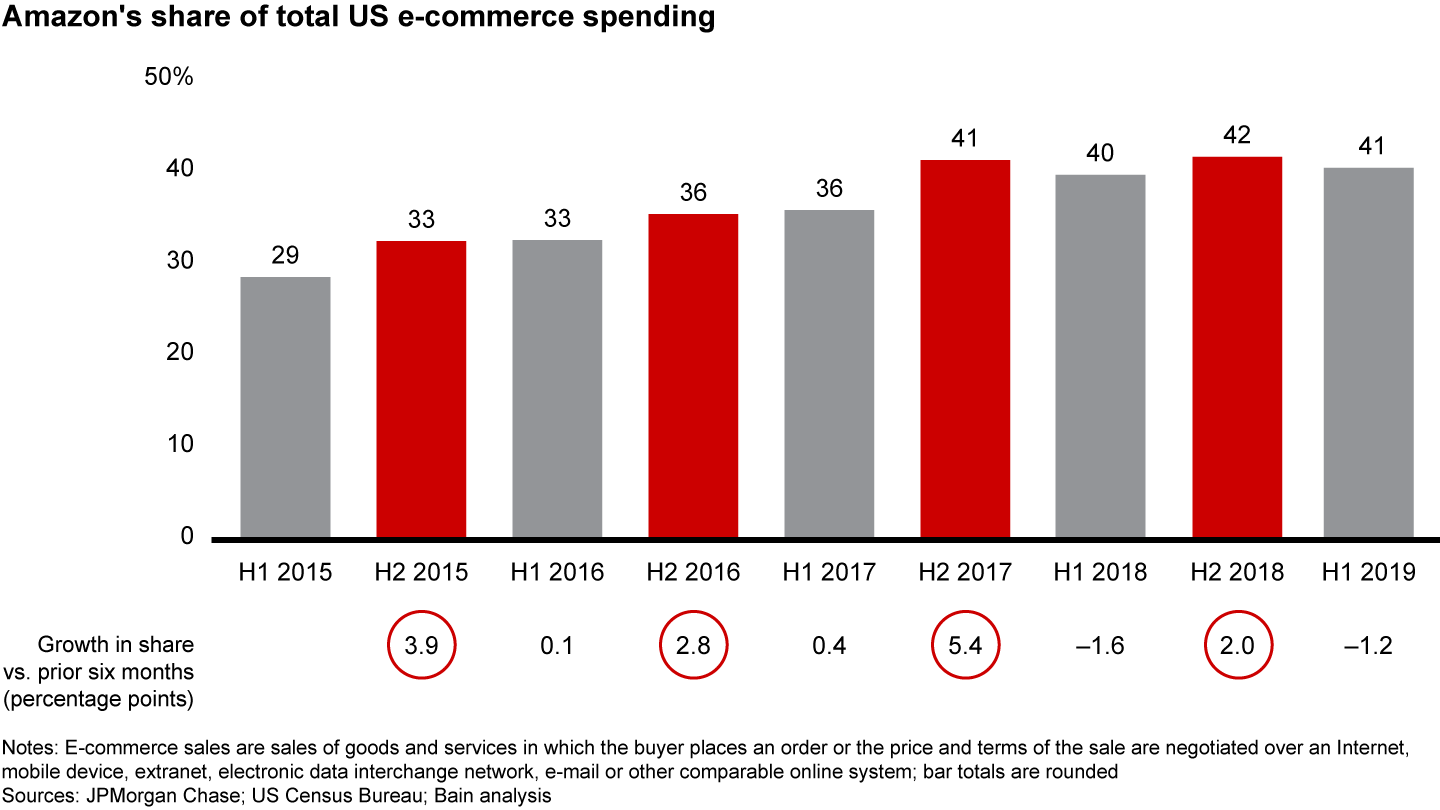

This year is starting out a little differently
To keep its holiday tradition of gaining share alive, Amazon will need to outpace our forecasted e-commerce holiday growth rate of 15%. But for all its might, Amazon is facing a bumpier sleigh ride this holiday season than in prior years: It will have to contend with stronger competitors and declining social sentiment.
Research we conducted with ROI Rocket suggests that although Amazon has strong overall customer advocacy, competitors have made significant inroads in recent years. Amazon’s Net Promoter Score®—a measure of a customer’s likelihood to recommend a store or brand—still ranks in the top half of retailers across all but one of the categories we evaluated. However, Amazon’s customer advocacy isn’t keeping step with competitors: The e-commerce giant’s Net Promoter Score rank has declined in six of nine categories since 2017 (see Figure 4). Meanwhile, category specialists such as Sephora, HomeGoods and REI have upped their game, earning the top Net Promoter Score for their respective categories.
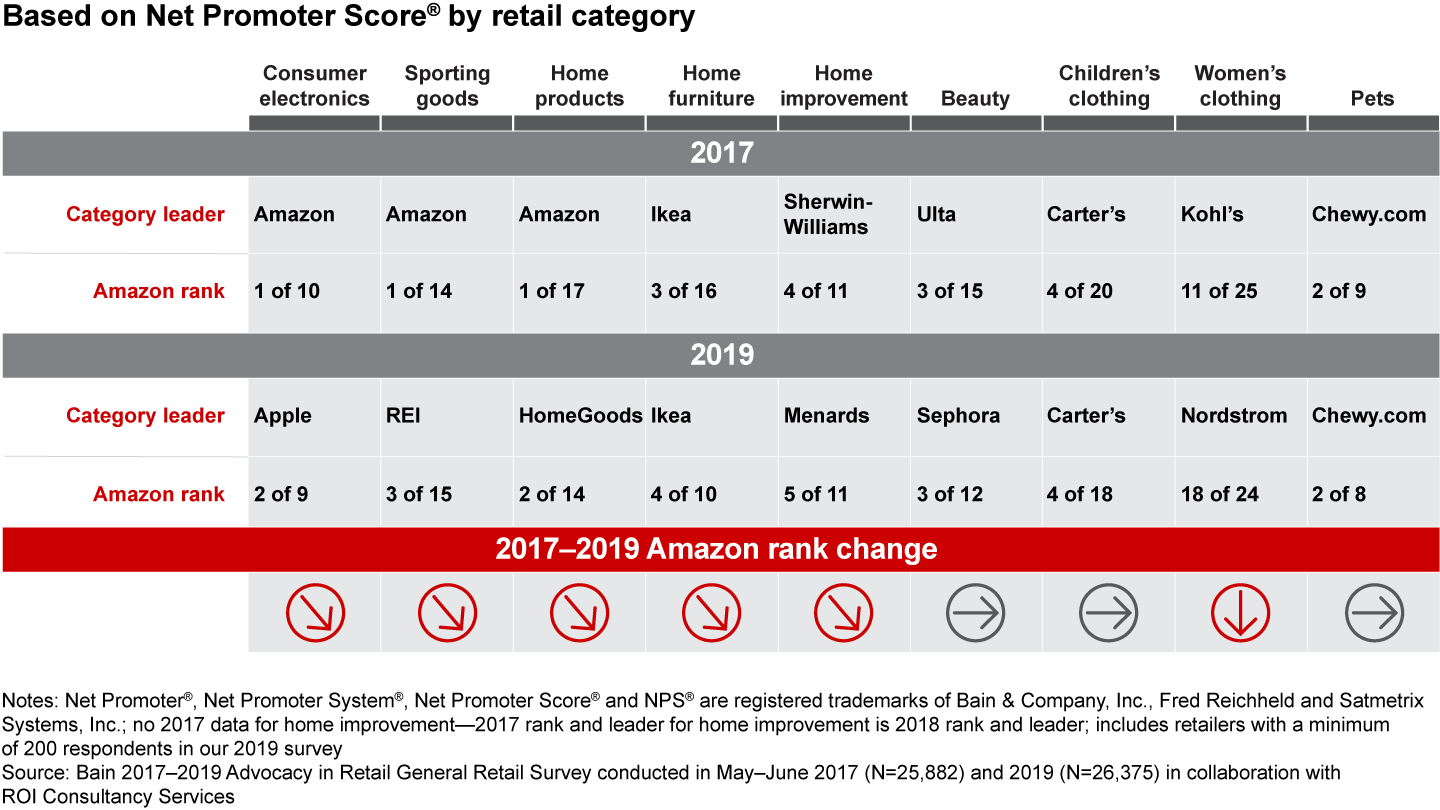

In addition, Amazon’s consumer sentiment on social media is declining. Bain collaborated with Brandwatch to analyze millions of social media posts and found that the proportion of negative and neutral comments about Amazon has increased over time, while the share of positive comments has decreased (see Figure 5).
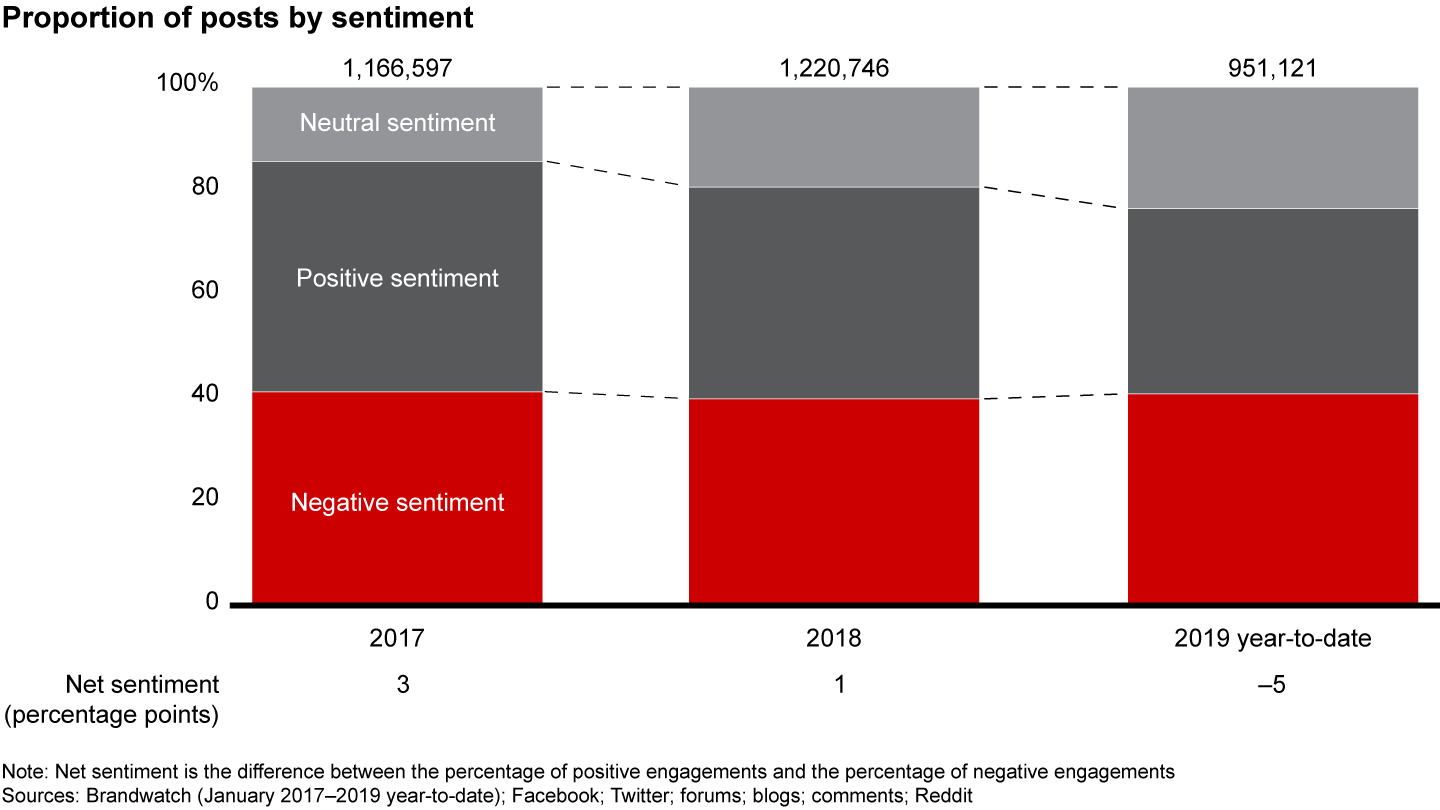

Although customers frequently express their love for Amazon, they have recently cited concerns about corporate issues, such as Amazon’s treatment of workers and anticompetitive behavior. Shipping and delivery issues, poor product quality and customer experience were also common concerns. Since 2017, dissatisfaction with corporate Amazon and customer experience has increased significantly. By contrast, negative comments related to order fulfillment and pricing have relatively diminished.
If historical patterns hold, Amazon’s customer sentiment is likely to erode further in the coming weeks, as negative sentiment tends to increase during the holiday season (see Figure 6). While customer sentiment alone can never tell the full story, a surge of negative commentary could erode customer trust and dampen an integral component of Amazon’s winning strategy—customer experience.


What to expect this holiday season
Will this be the year Amazon’s growth stops outpacing the market? Retailers certainly can’t count the e-commerce behemoth out yet. Although it’s early in the holiday season, Amazon seems to be pushing the boundaries of its winning playbook by expanding its deep and attractive assortment, using its scale to pass along low prices, and delighting with its fast omnichannel fulfillment and excellent customer experience. However, retailers such as Target, Walmart and Best Buy are responding in kind and closing competitive gaps.
Product: Lining up the right assortment
Amazon is famous for its endless aisle—after all, it offers more than 600 million SKUs. But having the world’s biggest selection only matters if it includes items that customers want to buy, from the top national brands that consumers love to high-value products unique to Amazon. This holiday season, Amazon is making moves to improve its assortment and fuel growth in areas of long-established strength, such as electronics, as well as relatively underpenetrated categories, such as prestige beauty.
Voice devices are the star atop the tree for Amazon: Alexa products alone represent nearly half of Amazon-branded electronic device sales, and the Echo Dot was Amazon’s holiday top seller in both 2017 and 2018. Amazon seems to be hoping for a three-peat this year, releasing a slew of voice products, such as the Echo Dot with Clock, just in time for the gift-giving season. While more than 30% of US households already own at least one voice speaker device, Amazon is betting that model upgrades spur shoppers’ desire to have Alexa in every room of their house.
Beyond Alexa, Amazon recently announced 20 new Fire TV products and launched 9 new private brands this year in categories ranging from apparel to energy drinks, bringing its global total to 144. Its private brands have been most successful in categories in which products are highly functional with little differentiation but have high margins that leave room for Amazon to cut prices (for instance, batteries and cell phone accessories). As Jeff Bezos likes to say, “Your margin is my opportunity.”
However, in categories in which brands matter more, Amazon has seen mixed results. In apparel, for instance, Amazon has launched more than 60 brands over the past few years. Bain's research with Pyxis indicates that, while Amazon's largest women's dress brand, Lark & Ro, has grown approximately 20% annually over the past three years, that growth is off a very low base. The brand has earned only 1% or less penetration of the women’s dresses category since its launch in 2016.
The story in beauty and personal care, however, is a bit different. In partnership with Ascential, we found that sales of Amazon’s private-label beauty and personal care products have grown more than 300% during the past year alone, while the brands’ collective penetration has tripled. While again off a small base, it is encouraging news for Amazon given its investment in this category.
Exclusive partnerships with top names are also on the rise. A slate of celebrities, from Rihanna to Lady Gaga to Heidi Klum, have recently launched beauty and apparel lines on Amazon, taking advantage of its vast customer reach and grabbing attention via its Prime Video platform. Popular direct-to-consumer brands such as Tuft & Needle and Hanna Andersson have also recently collaborated with Amazon to create exclusive product lines in home and apparel.
As another means of improving its assortment, Amazon is looking to better relations with its sellers and resellers. Amid recent regulatory inquiries, it is investing hundreds of millions of dollars in technologies to prevent counterfeit goods. The retailer has also lowered third-party seller fees in select categories, such as beauty, jewelry and furniture.
Pricing: Continued low prices where they count
Low prices have been a perennial feature of Amazon’s winning playbook, and early indications suggest this will continue to ring true during the holiday season. In partnership with DataWeave, we compared Amazon’s pricing with top competitors on like-for-like items across categories. Amazon had the lowest price 30% to 50% of the time and matched the lowest price in 35% to 60% of the remaining cases (see Figure 7). Perhaps more importantly, customers believe that Amazon offers low prices. According to research we conducted with ROI Rocket, customers said “value for the money” was one of their top purchase criteria across most product categories. The same shoppers perceive Amazon as a value leader, ranking it in the top one to three retailers of all categories evaluated, with the exception of women’s clothing and pet supplies.


In prior years, Amazon has focused on offering competitive pricing on popular traffic-driving items and during high-traffic periods—and the retailer shows no signs of stopping this holiday season. It temporarily slashed prices on its top-selling Fire TV Stick to compete with Roku’s Express HD launch in October, and it cut prices on rarely discounted Apple products, such as the iPad Pro, for Prime Day (which it extended to two days for the first time this year). The retail giant also discounted its Apple Watch lineup in October ahead of this year’s Black Friday promotions. As we near the biggest shopping weekend of the year, expect Amazon to extend aggressive discounts to its Echo and Fire product lineups as well.
However, Amazon’s days as the absolute lowest-priced retailer may be numbered. Competitors are already investing to avoid being undercut this holiday season. Walmart, for example, in an effort to match Amazon’s holiday price points, recently introduced a program to subsidize price cuts on its third-party marketplace products. If competitive responses alter customers’ perceptions this holiday season, Amazon could lose its hold on the pricing advantage.
Omnichannel fulfillment (and returns): Delivering on multiple fronts
Amazon, which has long set the standard for fast and free (or prepaid via Prime membership) shipping and returns, has upped the ante yet again this year. The retailer announced free one-day shipping on more than 10 million items for its US Prime users in April. It also appears to be phasing out its US add-on program—a requirement to bundle small, low-price items into larger orders—to effectively remove a spending threshold on next-day shipping. In an effort to outperform competitors on convenience, Amazon has expanded its Prime Now two-hour delivery program to more than 80 US cities, up from about 60 last year, and it made Amazon Fresh grocery deliveries free for Prime customers.
However, similar to years past, some major retailers are pushing to match Amazon over the holidays. Target is offering free next-day shipping on more than 100,000 items between November 1 and December 21, same-day delivery (as soon as an hour) with Shipt in select locations and same-day Drive Up order pickup at its stores. Best Buy and Walmart have similarly unveiled next-day shipping offerings just in time for the season.
Amazon’s competitors have the advantage of using their physical stores as fulfillment centers. Brick-and-mortar stores still account for more than 80% of US retail sales, and retailers are increasingly using stores to provide customers with added omnichannel convenience through offerings such as buy online, pick up in store (BOPIS). Amazon offers similar services but has a relatively small footprint. Despite significant press coverage forecasting more than 3,000 brick-and-mortar stores by 2021, the e-commerce titan is far from that goal. Amazon currently has 537 stores, including 484 Whole Foods locations, but it is still searching for winning formulas (see Exhibit A in the appendix). For example, Amazon shuttered more than 80 of its Pop-Up stores in April after the concept failed to gain traction, and it only added a combined 22 locations of its Go, Books and 4-star concepts this year. The retailer also has yet to unveil further details on its new grocery concept, which it announced back in March.
Yet Amazon’s owned store count is just a small component of its omnichannel offering. The company recently escalated partnerships, offering more conveniences to an increasing number of customers. Kohl’s has expanded its Amazon Returns program, which allows customers to drop off Amazon returns at all of its stores free of charge. Amazon’s Counter program, launched in June, allows customers to pick up Amazon packages at its partner stores—namely, Rite Aid, GNC, Health Mart and Stage Stores—totaling thousands of locations across the US. Collectively, these programs provide more convenient shipping options, offering a secure delivery point for packages as well as simpler returns by accepting unwanted items without a box or label. If Amazon were to roll out this program to every partner store, the online giant would gain more than 15,000 physical locations across the country and reach more than 250 million Americans, according to Bain analysis (see Figure 8). Already, customers seem to be taking advantage—Kohl’s has reportedly seen up to a 24% uptick in foot traffic following implementation and expects store sales to improve under the partnership.
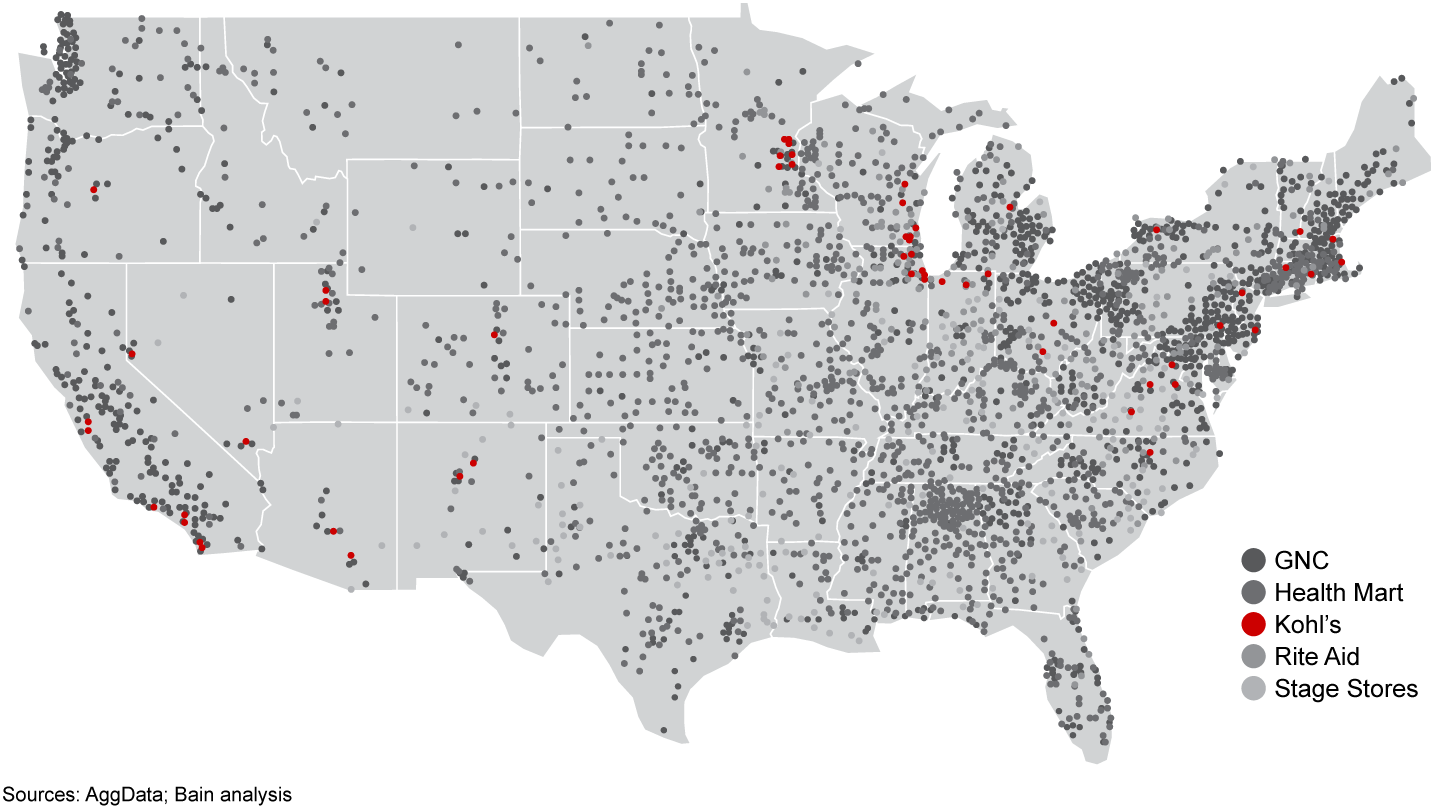

How retailers can outperform Amazon
Amazon is a powerful competitor, but some retailers are gaining traction and thriving in a rapidly evolving retail landscape. Their innovative approaches offer hope and lessons for others. Specific strategies for competing and winning will vary based on a retailer’s market position (see the Bain Brief “The Future of Retail: Winning Models for a New Era”). Nonetheless, all retailers should focus on five imperatives to prosper this holiday season and position themselves for a successful new year.
- Strengthen your differentiation. After mastering the foundational basics on assortment, pricing and customer service, focus on the “wow” factor that Amazon can’t offer. Winning retailers take several different approaches, often starting with unique products and services. Sephora has developed a strong private brand program supplemented with celebrity and fashion house exclusives. The beauty retailer is always looking for the next “it” product by identifying insurgent brands with the Kendo brand incubator. Costco and Aldi have succeeded in the crowded landscape of value grocers by limiting SKUs to focus on sharply priced private-label best sellers that fly off the shelves. Apple and Best Buy offer services and training on the hardware and software they stock rather than simply selling the products.
- Obsess over customers and their experiences. Develop a deep understanding of your customers’ shopping journeys, and determine how to win at key touchpoints. American grocer H-E-B has achieved industry-leading customer advocacy by delivering a seamless customer experience both online and in store. Nearly one in five H-E-B customers has used the grocer’s online sales channels—including delivery and BOPIS—citing ease and convenience as the motivating factors. In store, H-E-B delights customers with localized assortments, convenient layouts and quick checkouts.
- Find the fuel for big investments. Of course, investing in products and customers isn’t free. Leading retailers systematically and creatively cut costs without hurting the customer experience. For example, Target moved digital fulfillment from distribution centers to stores, reducing costs by 40%. These savings were reinvested in other customer experience improvements—namely, major store redesigns that resulted in 2% to 4% more growth over older store formats and the hiring of more than 130,000 holiday workers.
- Embrace analytics. Winning against Amazon will require the full attention of your finest analytic minds. Build advanced analytics capabilities that inform basic decisions—such as assortment, replenishment and pricing—and find ways to incorporate data to support more complex, game-changing challenges. Early on, Wayfair’s data science team, made up of more than 100 employees, mastered the basics of using analytics to make inventory and pricing decisions. The team now spends its time developing cutting-edge, data-informed recommender systems and computer vision tools to meet customer needs.
- Accelerate innovation (and learn fast). Innovation is powerful when done well but deadly if ignored, yet few retailers have mastered this mindset and capability at scale. Walmart is harnessing this power, turning to Agile methodologies as it integrates stores and digital operations. And you don’t have to look much further than lists of retail bankruptcies for tales of caution. To meet customers’ rapidly evolving needs, embrace Agile principles such as cross-functional teams and rapid prototyping.

Doing Agile Right: Transformation Without Chaos
Agile has the power to transform work—but only if it's implemented the right way.
Given the rising consumer demands and digital advances that are rewriting the rules of the industry, retailers cannot afford to stand still. Amazon will be investing an estimated $100 billion more into IT than even the largest traditional retailers over the next five years at current spending rates, according to Bain research. To keep up, retailers will need to make tough trade-offs and take action. Will they fold, or will they call and raise Amazon?
Looking forward: Future release dates and topics
Here’s a preview of our upcoming newsletters:
- Issue 3 (early December): Supply chain holiday magic
- Issue 4 (mid-December): Boosting holiday traffic
- Issue 5 (mid-January): Post-holiday recap and resolutions for 2020
We look forward to sharing holiday headlines with you and hearing your feedback throughout the holiday season.
Appendix


About our research partners
Ascential is a global specialist information company that partners with businesses to win in the digital economy. Edge by Ascential provides customers with comprehensive and actionable e-commerce–driven data, such as real-time digital shelf performance metrics, monitoring of price movements and product listings, and SKU- and category-level online sales and share. For more information about Ascential, visit www.ascential.com.
Brandwatch (formerly Crimson Hexagon) is the developer of ForSight, a software platform that identifies statistical patterns in words used in public online texts and social media platforms. Researchers enter key terms using Boolean search logic so that the software can identify relevant material and use proprietary machine learning algorithms to perform an analysis. To learn more about Brandwatch, please visit www.brandwatch.com.
DataWeave provides competitive intelligence as a service to e-commerce businesses and consumer brands via massive scale aggregation and analysis of web data. The company’s AI-powered technology platform enables retailers to make smarter pricing and merchandising decisions to drive profitable growth as well as consumer brands to protect their online presence, enhance their availability and optimize their discoverability. To learn more about DataWeave, visit www.dataweave.com.
Jumpshot provides insights about online user actions that help e-commerce companies and brands gauge how and where customers are clicking and buying. The company’s real-time, anonymized global panel tracks 5 billion actions a day across 100 million devices. Jumpshot’s clients include major companies in industries such as consumer products, media, technology and healthcare. To learn more about Jumpshot, visit www.jumpshot.com.
Pyxis is a consumer behavior analytics firm that analyzes billions of e-commerce and in-store purchases conducted by millions of consumers. Pyxis uses its SKU-level data and proprietary algorithms to generate detailed reports about market share, market size, customer loyalty and pricing power for leading consumer companies. To learn more about Pyxis, visit www.pyxisintel.com.
ROI Rocket, a provider of Bain Certified Net Promoter Score studies, offers full-service research, marketing and sales automation as well as digital agency support to consultants, investors and corporate clients. For details, visit www.roirocket.com or contact Noah Seton (noah.seton@roirocket.com).
-
Selected references
Bain & Company has included in this document information and analyses based on the sources referenced below as well as our own research and experience. Bain has not independently verified this information and makes no representation or warranty, express or implied, that such information is accurate or complete. Projected market and financial information, analyses and conclusions contained here are based (unless sourced otherwise) on the information described above, and Bain’s judgments should not be construed as definitive forecasts or guarantees of future performance or results. Neither Bain & Company nor any of its subsidiaries or their respective officers, directors, shareholders, employees or agents accept any responsibility or liability with respect to this document.
“Americans Adopt AI: Smart Speakers See Largest Gain in U.S. Household Ownership, Says CTA Study.” Consumer Technology Association, press release, May 9, 2019.
Boyle, Matthew. “Walmart Subsidizing Some Vendors in Price War with Amazon.” Bloomberg, October 14, 2019.
Del Rey, Jason. “Amazon’s New Weapon to Crush Competition: $1 Items Delivered for Free—by Tomorrow.” Vox, October 14, 2019.
Estrada, Maren. “The Fire TV Stick and Fire TV Stick 4K Are Back Down to the Lowest Prices Since Prime Day.” BGR, October 16, 2019.
Frazier, Mackenzie. “The Apple Watch 3 Gets a $90 Price Cut at Amazon Ahead of Black Friday.” TechRadar, October 22, 2019.
Gasparro, Annie and Laura Stevens. “Brands Invent New Lines for Only Amazon to Sell.” The Wall Street Journal, January 25, 2019.
Graham, Jefferson. “Yes, You Will Save on Prime Day, Especially for Amazon Products.” USA Today, July 15, 2019.
Green, Dennis. “Amazon Is Closing All 87 of Its Pop-Up Stores, Reportedly Laying Off All Employees.” Business Insider, March 6, 2019.
Howland, Daphne. “Target Takes on Amazon with Enhanced Holiday Fulfillment.” Retail Dive, October 24, 2019.
Kapadia, Shefali. “Target Cuts Costs 40% through Store Fulfillment.” Supply Chain Dive, May 23, 2019.
Kim, Eugene. “Amazon Quietly Launched 7 Fashion Brands While Ramping Up Hiring for Its Own Clothing Line.” Business Insider, February 22, 2016.
Lunden, Ingrid. “Amazon Axes $14.99 Amazon Fresh Fee, Making Grocery Delivery Free for Prime Members to Boost Use.” TechCrunch, October 29, 2019.
Maheshwari, Sapna. “Kohl's Is Betting on Amazon Returns to Drive Sales.” The New York Times, July 8, 2019.
Meek, Andy. “Amazon Unveiled Over 20 New Fire TV Devices, Including the Fire TV Cube.” BGR, September 4, 2019.
Moon, Mariella. “Amazon's Prime Day Will Be Two Days This Year.” Engadget, June 26, 2019.
Morris, Chris. “Best Buy Launches Free Next-Day Deliveries in Latest Salvo Against Amazon.” Fortune, October 22, 2019.
Perez, Sarah. “Report: Amazon Is Planning a Whole Foods Expansion to Benefit Prime Now.” TechCrunch, December 31, 2018.
Peterson, Hayley. “Kohl's CEO Said Amazon Returns Boosted Traffic—and Data Shows the Jump Could Be As High As 24%.” Business Insider, August 20, 2019.
Reagan, Courtney. “Walmart Announces Executive Shuffle to Further Integrate Stores and Digital.” CNBC, July 19, 2019.
Soper, Spencer. “Amazon Will Consider Opening Up to 3,000 Cashierless Stores by 2021.” Bloomberg, September 19, 2018.
Tambini, Olivia. “New Amazon Echo Speakers Release Date, News and Features.” TechRadar, September 25, 2019.
Thomas, Lauren. “Target CEO Brian Cornell Expects to Spend $50 Million More on Payroll to Staff for Busy December.” CNBC, October 23, 2019.
“TJI Amazon Brand Database.” TJI Research, database, accessed November 5, 2019.
US Census Bureau, “Advance Monthly Sales for Retail and Food Services, September 2019.” News release, October 16, 2019.
“Wayfair Data Science.” Wayfair, accessed November 5, 2019.
Zimmer, Kurt. “Lynx: Identifying Wayfair Customers' Functional Needs.” Wayfair, July 17, 2019.
Suzanne Tager is a senior director with Bain & Company’s Global Retail practice, and she is based in the firm’s New York office. Darrell Rigby leads Bain’s Global Innovation practice, and he is based in the Boston office. Aaron Cheris leads the firm’s Retail practice in the Americas, and he is based in San Francisco.
The authors would like to acknowledge Sara Magenheimer, Muhammad Eltahir, Mark Heneine, Amanda Sload, Daniel Topler-Garcia, Emily Harris and Carlyn Kinn for their contributions to this newsletter.
Net Promoter Score®, Net Promoter System®, Net Promoter® and NPS® are registered trademarks of Bain & Company, Inc., Fred Reichheld and Satmetrix Systems, Inc.